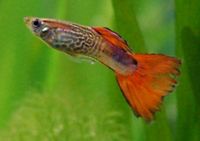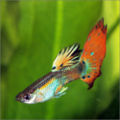Guppy (Poecilia reticulata)
From The Aquarium Wiki
Revision as of 16:00, 23 May 2017 by Supreme Sawk (talk | contribs)
Poecilia reticulata
38 Litres (10 US G.)
5.1-6.4cm (2-2.5 ")
5.5 - 8.0
17.8-27.8°C (64 -82 °F)
6-15 °d
1:3 M:F
2-4 years
Family
Poeciliidae
This animal is available captive bred
Contents
Additional names
- Guppy, Fancy Guppy, Millions Fish, JAW Fish, Rainbow Fish
Additional scientific names
- Acanthophacelus guppii, Acanthophacelus reticulatus, Girardinus guppii, Girardinus reticulatus, Haridichthys reticulatus, Heterandria guppyi, Lebistes poecilioides, Lebistes poeciloides, Lebistes reticulatus, Poecilia reticulate, Poecilia reticulatus, Poecilioides reticulatus
Origin
- Native to Venezuela, Barbados, Trinidad, northern Brazil and the Guyanas but introduced into many other countries.
Sexing
- Male guppies have longer, wider flowing tails and dorsal fins. The bodies of males are typically more colourful than their female counterparts. Females are considerably larger than males, have a white or clear body and may display a colourful tail, although shorter and not as flowing.
- Aside from colouration, sex can also be determined by the presence of the gonopodium organ. Mature females also have a dark gravid spot near their vent. If she is pregnant, the gravid spot will be a large, dark brown, or more commonly, black spot. If she is not pregnant however, the gravid spot will be a small dot ranging in colour from brown to yellow-orangish, depending on the individual fish. In some specimens, as pregnancy advances to the last few days before birth, you will be able to see the eyes of the unborn fry in place of the gravid spot.
Breeding
- To have a group of guppies of male and females that breed, a minimum of a 57 Litres (15 US G.) aquarium is required. If you are not separating fry from the adults, the fry will need to be moved to a breeding device, such as a net breeder, it's a good idea to add a portion of Java Moss to the aquarium, as it will provide shelter and food for small fry.
- Pregnant females should not be put into a net breeder or trap prior to giving birth as this will cause them undue stress and possibly cause them to abort the fry.
- The ease in which this species breeds and the wide variety of colour and fin shapes has caused the development of a show culture in the aquarium hobby. Many breeders have developed particular types of guppies that they sell at high prices and for prizes.
- Generally guppies are considered very easy to breed. If the breeder is not concerned about genetic heritage or the breeding for color or a specific attribute, simply putting male and female guppies in the same tank will yield offspring within a month. Females have a gestation period of around 21-28 days. The variations in gestation period are influenced by the number of hours of daylight each day, by temperature and by genetics.
Tank compatibility
- Guppies cohabit with many different kinds of fish because of their docile nature. Sometimes, although rarely, males will attack other fish of the same body shape and tail appearance. This happens mainly to other livebearers such as Swordtails and other male Guppies, and is harmless showing-off for the females. Usually no real harm is done.
- Some good tank mates are, but are not limited to:
- Corydoras catfish
- Otocinclus catfish
- Dwarf Gourami (Dwarf Gouramis will eat fry that it can see and catch, but harmless to adults.)
- Snails
- These are a very tiny handful of tank-mates, and there are a large amount of others.
- Do not keep these fish with Tiger Barbs or other known fin-nippers such as Serpae Tetras, as Guppies can sometimes be nipped especially the males with elongated finnage. Large predatory fish should also be avoided such as larger Cichlids including Angelfish. Nor should they be kept with Betta splendens, specifically the male Bettas with male Guppies, as these are territorial fish known for mistaking male Guppies as other Bettas and killing them.
Diet
- Guppies are omnivores and will eat algae-based flake food, freeze-dried bloodworms, tubifex, brine shrimp, and flakes. Also will eat small parts of fresh earthworms and whole parts of bloodworms. They also like to eat some blanched vegetables like courgette, cucumber or lettuce. Algae wafers are also good to provide variety in the diet.
Feeding regime
- Feed once or twice a day sparingly.
Environment Specifics
- Good water quality, lightly planted. No rough edges on ornaments to damage fins. There should be plenty of open swimming space. Due to overbreeding, many Guppies can be quite fragile so water quality should be kept optimum.
Behaviour
- Docile, active and sociable. Breeding requires virtually no effort. Because of this they are sometimes called J.A.W. fish for Just Add Water fish.
Identification
- Small with brightly-coloured, usually triangular tails, with typically greyish-silver bodies, a pointed nose and upturned mouth. Many different colour and tail type variations have been selectively bred. Wild types have much shorter tails, whereas captive bred fancy males have very elaborate tails and tail types.
Pictures
Videos
| 3rd International Guppy Show 2008: | King Tiger Fancy Guppy: |
Links
- Fishbase (Mirrors:
 )
)






